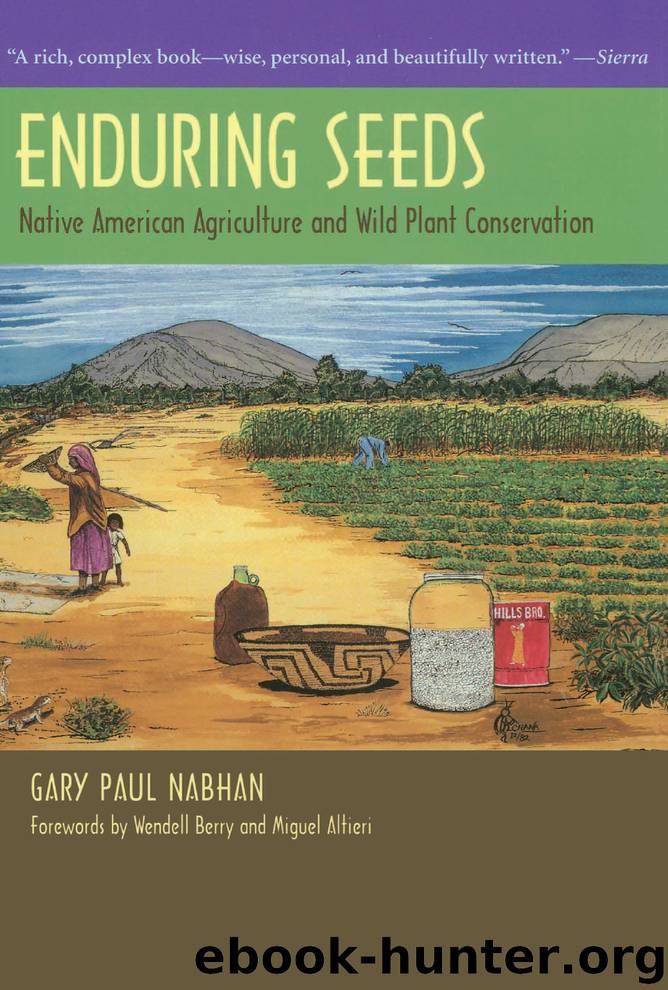Enduring Seeds by Gary Paul Nabhan

Author:Gary Paul Nabhan
Language: eng
Format: epub
Publisher: University of Arizona Press
Published: 2016-09-05T16:00:00+00:00
Part Two
The Local Parables
CHAPTER SEVEN
Wild-Rice:
The Endangered, the Sacred, and the Tamed
I.
I had driven two hours out of my way to try to see an aquatic grass that seldom, if ever, gets its head above water. Descending out of the Texas Hill Country, I was supposed to be on my way to Houston on the Gulf Coastal Plain. But the story of Zizania texana, Texas wild-rice, had pulled me off course and into a landscape too manicured and manipulated for its own good.
As I drove along, idly listening to an Austin country-and-western radio station in my rented car, I hummed a sad song that summed up my pilgrimage. It was “ Needle-in-Haystack Time Again,” looking for a plant so rare that I’d need a worlds expert to take me to it. Fifty years ago, Texas wild-rice was abundant along several miles of the San Marcos River, and in the irrigation ditches flowing from it. A decade ago, Dr. W. H. P. Emery found it only within a thousand square yards of the river— an area about one seventh the size of The Alamo in nearby San Antonio. What's more, streamflow had been increased to the extent that the seedheads, which were formerly raised a yard above the water, are now constantly pummelled by the current so that they remain submerged, incapable of sexual reproduction.
As conservation biologist David Riskind explains it, this Texas wild-rice “ is barely hanging on because it is [left with] surviving in a completely alien habitat. It used to thrive as an emergent along a spring run. Since the San Marcos has been dammed, the species must cope with survival as a submerged aquatic.” In short, the Texas wild-rice habitat is as converted as a box of Uncle Bens.
Although this grass is not closely akin to Uncle Ben’s white rice— Oryza sativa, one of humankind’s mainstays— it is related to two minor cultivated crops, Zizania palustris, and Z. latifolia. Northern wild-rice, Zizania palustris, grows around the Great Lakes and surrounding watersheds. Its dark, quill-like grain has been eaten and revered by Algonquian-speaking tribes for millennia. It is now found mixed with true rice in most American markets. Manchurian water-rice, Z. latifolia, is grown mostly for its fungus-infected stalks, eaten as a vegetable called gau-sun. Its cultivation, however, may originally have been for grain rather than for greens. Manchurian wild-rice is described in Chinese herbals written a thousand years ago. Three thousand years ago, its seeds were featured in rituals of the Chou Dynasty.
As I leaned on the railing of a bridge crossing the San Marcos River, it was evident to me that Z. texana had no sacred status locally. The Tonkawa and Comanche bands that once lived along the river are long gone. For the last two-and-a-half centuries, one group of immigrants after another has disrupted the local environment. The so-called “ natural range” of this perennial grass is now restricted to the small patches that cover
Download
This site does not store any files on its server. We only index and link to content provided by other sites. Please contact the content providers to delete copyright contents if any and email us, we'll remove relevant links or contents immediately.
| African-American Studies | Asian American Studies |
| Disabled | Ethnic Studies |
| Hispanic American Studies | LGBT |
| Minority Studies | Native American Studies |
Cecilia; Or, Memoirs of an Heiress — Volume 1 by Fanny Burney(32495)
Cecilia; Or, Memoirs of an Heiress — Volume 2 by Fanny Burney(31909)
Cecilia; Or, Memoirs of an Heiress — Volume 3 by Fanny Burney(31889)
The Great Music City by Andrea Baker(31756)
We're Going to Need More Wine by Gabrielle Union(19003)
All the Missing Girls by Megan Miranda(15773)
Pimp by Iceberg Slim(14433)
Bombshells: Glamour Girls of a Lifetime by Sullivan Steve(14020)
For the Love of Europe by Rick Steves(13557)
Talking to Strangers by Malcolm Gladwell(13290)
Norse Mythology by Gaiman Neil(13278)
Fifty Shades Freed by E L James(13186)
Mindhunter: Inside the FBI's Elite Serial Crime Unit by John E. Douglas & Mark Olshaker(9260)
Crazy Rich Asians by Kevin Kwan(9220)
The Lost Art of Listening by Michael P. Nichols(7453)
Enlightenment Now: The Case for Reason, Science, Humanism, and Progress by Steven Pinker(7272)
The Four Agreements by Don Miguel Ruiz(6698)
Bad Blood by John Carreyrou(6581)
Weapons of Math Destruction by Cathy O'Neil(6214)
